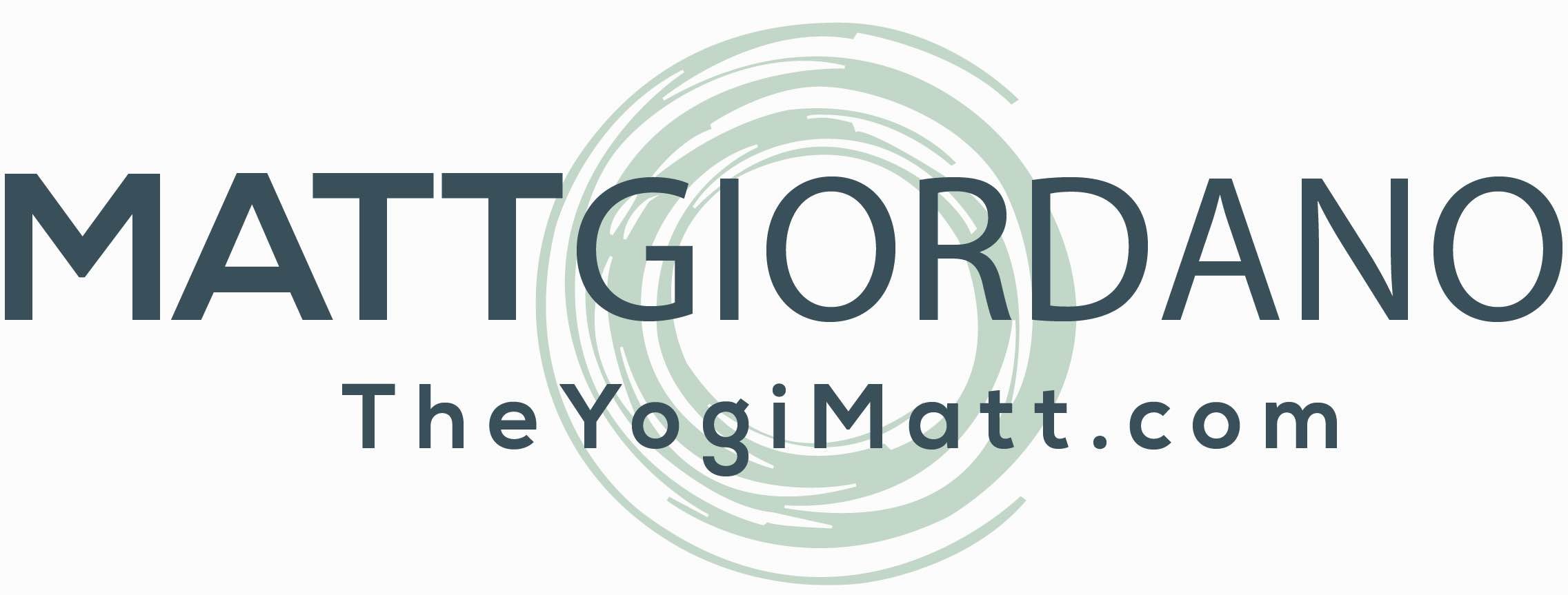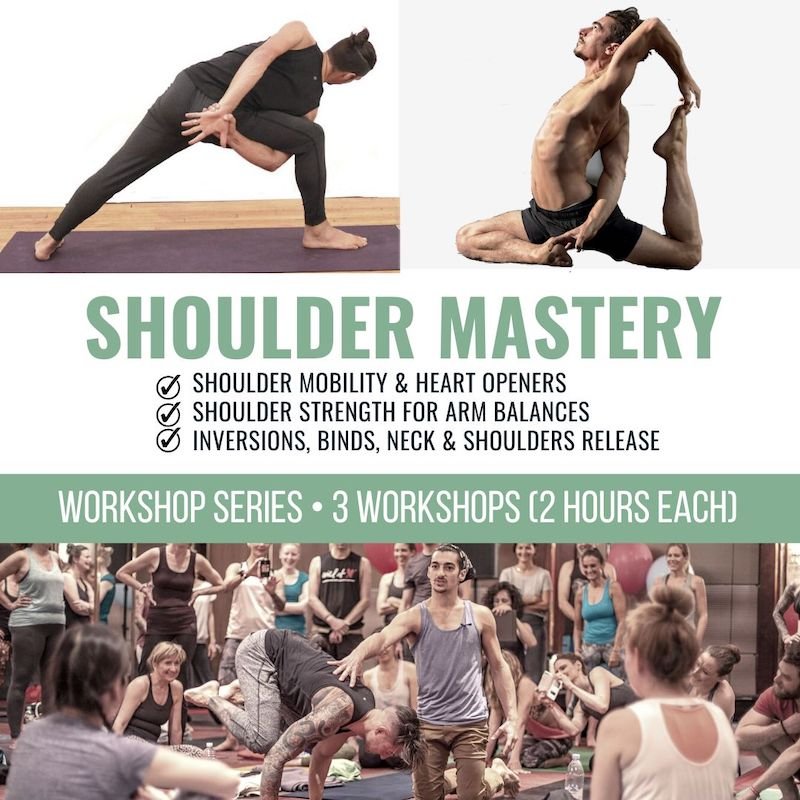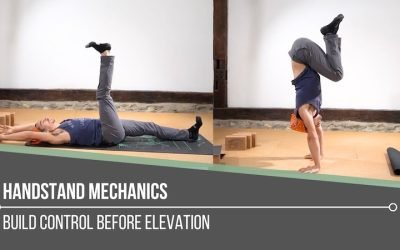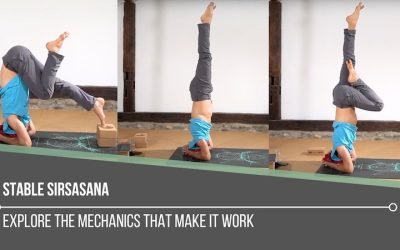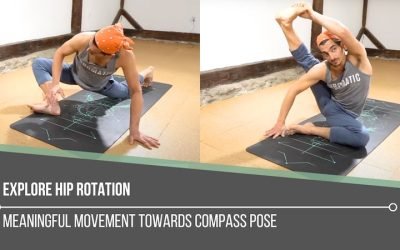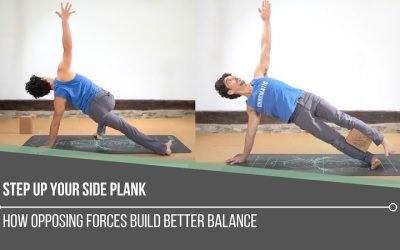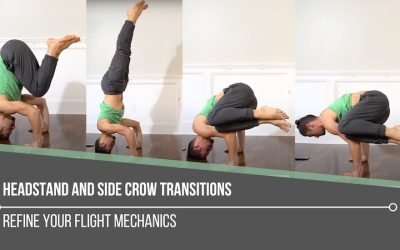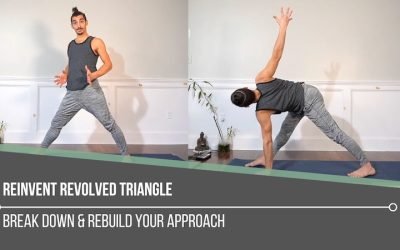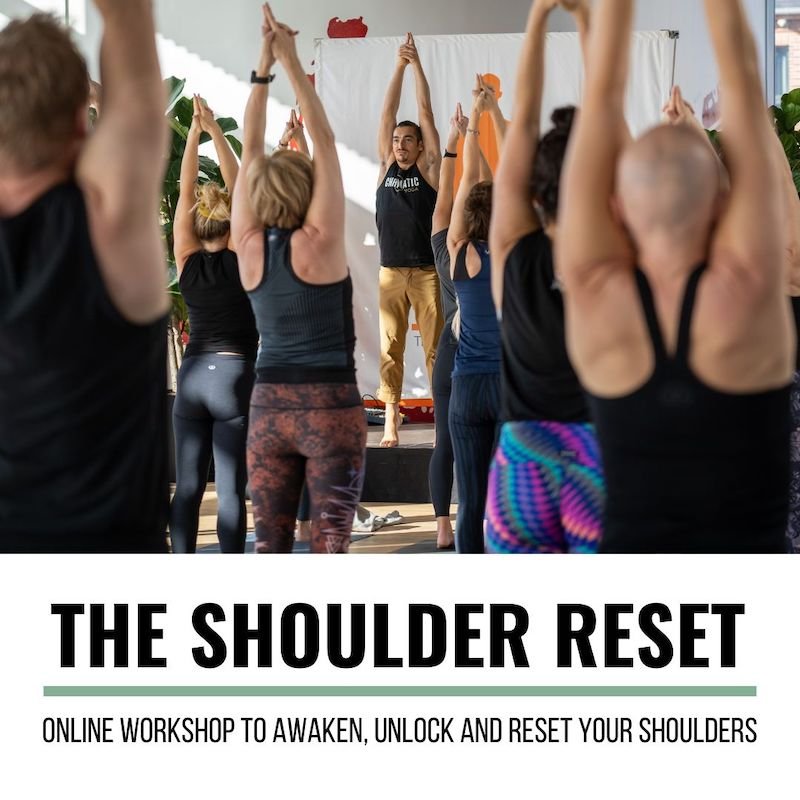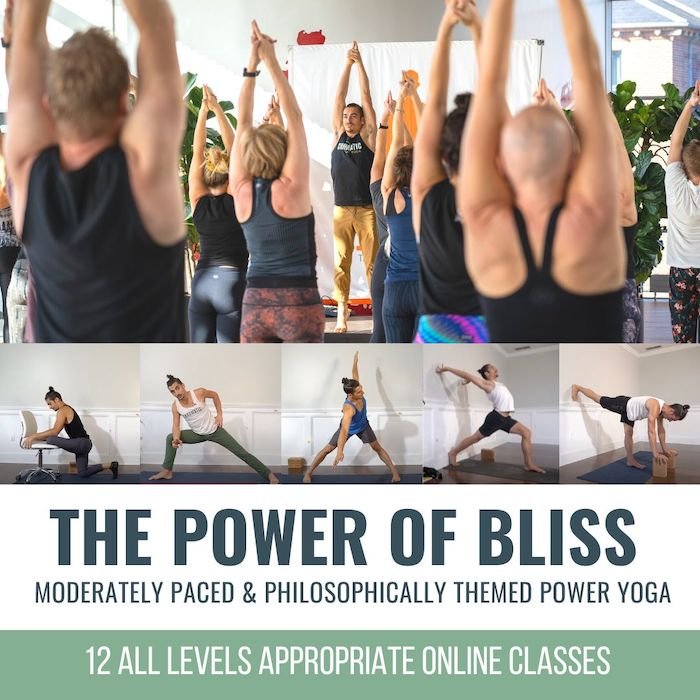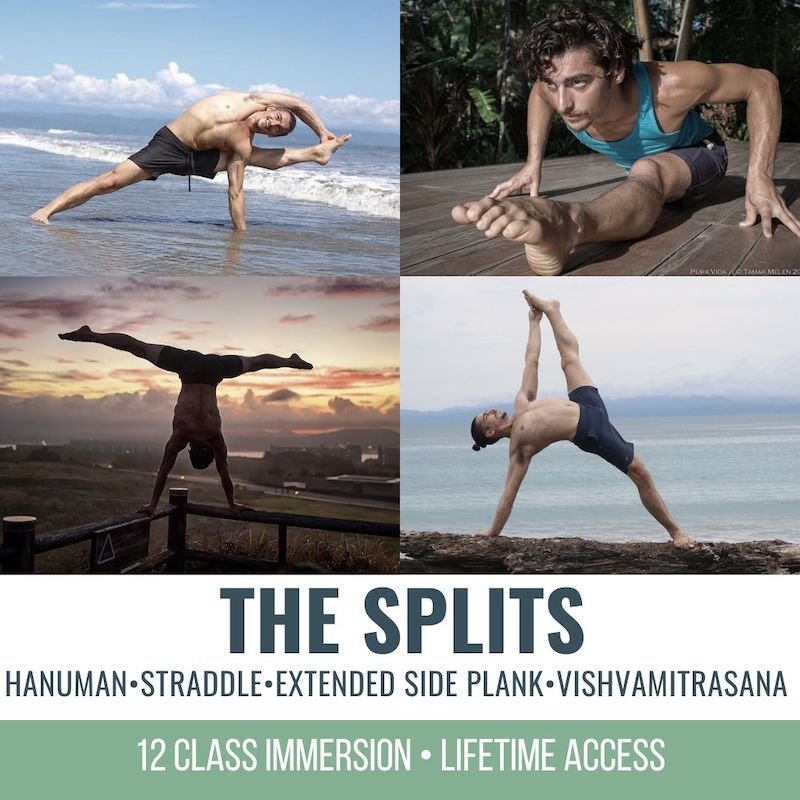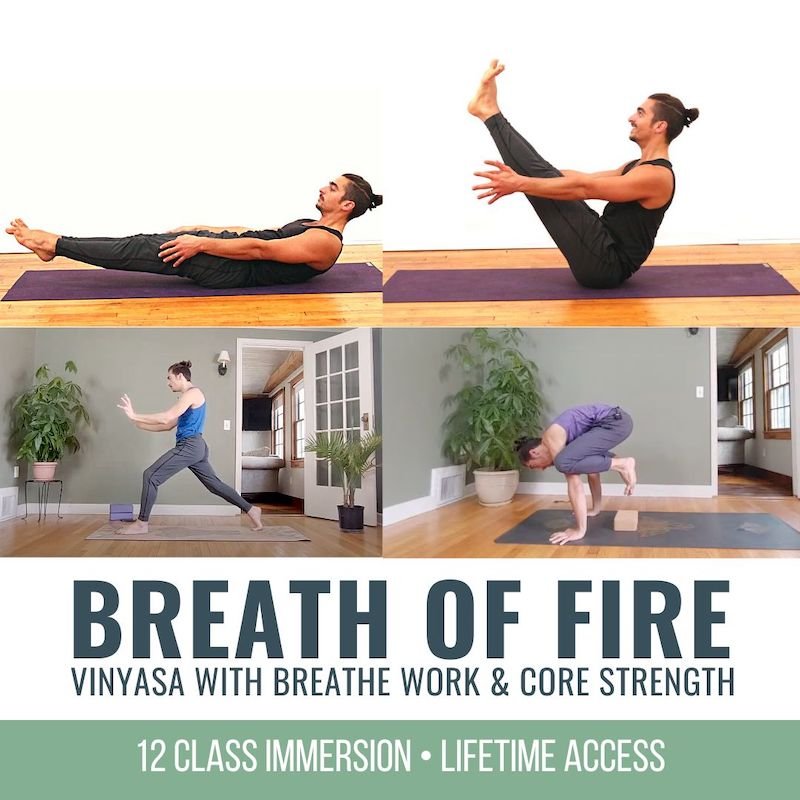Handstand MechanicsINVERSIONHANDSTAND MECHANICS Stability, strength, and coordination come together in the pursuit of mastering handstand mechanics. One of the most critical foundations is internal rotation at the hip joints, which can aid with certain entries and...
Shoulder Connections
Shoulder Connections
3 Postures for Increased Mobility
shoulder stability
SHOULDER CONNECTIONS
To increase mobility in our shoulders, we must first understand how they move, so we become more connected with their function and how they inform a variety of yoga postures. The exploration with intentional techniques is the key to gaining access to these postures.
In regard to heart-opening postures, “shoulder connections” are also about understanding how the retraction of the shoulder blades affects the chest, rib cage, abdomen, and spine. In today’s video, Matt demonstrates the shoulder actions needed to access 3-Part Cobra, Upward Dog with blocks, and Wild Thing. The way that the retraction of the shoulder blades is applied in these postures will not only create the desired heart-opening shape but also strengthen the muscles necessary for healthy shoulder mobility.
SHOULDER MASTERY
WORKSHOP SERIES
- 3 livestream workshops and replays
- Nondogmatic and effective alignment
- Improve low-back health
- Shoulder mobility + heart openers
- Shoulder strength + arm balances
- Inversions, binds, neck & shoulder release
- 6 hours of continued education
- Gain strength and stability
- Increase range of motion, flexibility, and mobility
- Step-by-step guidance: Everyone can follow and participate
- Educationally infused: Learn while you embody
- Livestream optional; all workshops available as livestreams (see dates below) and as on-demand replays for life
- Automatically receive access to the replays immediately after the livestream
3-PART COBRA
The sequence of actions in this posture teaches us the ability to authentically stretch the front body and strengthen the back body. There’s a greater requirement for us to recruit the muscles in the upper body due to the decreased reliance on the hands to hold us up (if we allow it). In the video, Matt starts the sequence of lifting the upper body off the floor by first using the leverage of the hands; in order to reduce compression in the lower back, he sends the rib cage forward, then pulls the belly in and up. Here’s the key though: It’s the activation of the rear deltoids, the retraction of the shoulder blades, and the action of pulling the chest through the shoulders that creates the “bowing of the spine” required in all backbends.
WATCH THE VIDEO
SHOULDER CONNECTIONS: 3 POSTURES FOR INCREASED MOBILITY
UPWARD-FACING DOG: PREPARATION WITH BLOCKS
If we pay attention to the smaller, more intricate details within the application of techniques in a posture, the benefits become more profound. First, Matt demonstrates the simple action of turning the fingers outward on the blocks. Lifting the shoulders up and back now becomes more accessible, which encourages the action of external rotation in the arms, promoting retraction of the scapulae and allowing for more opportunity to contract and strengthen the rear deltoids, rhomboids, lower fibers of the trapezius muscles, and the latissimi dorsi. The final action is to push the hands down into the blocks to access increased spinal extension along with greater heart opening.
200 HOUR ONLINE TEACHER TRAINING
GET CERTIFIED & DEEPEN YOUR YOGA PRACTICE
- Deepen your yoga practice
- Build confidence speaking in front of groups in person and online
- Learn foundational class structures and templates
- Learn techniques for a wide range of yoga postures
- Get certified and highly qualified to teach yoga
- Yoga Alliance Globally Recognized Certification Program
WILD THING
In Wild Thing, there are 3 shoulder actions that help create more expansion and mobility in the shoulders. First, we lift the bottom shoulder up, move it back (retract), and then bring the bottom wing tip of the shoulder blade around. These actions send the chest forward and up. The posture is different, but the same actions apply here as in 3-Part Cobra. In the full class, Matt reminds us that it can be easy to lose the integrity of the positioning of the shoulder once we start to lift up into the pose, but if we continue to connect with the sensation of muscle contraction between the shoulder blades, there’s more success in maintaining the shoulder position. Ideally, the chest is above the height of the shoulder. In order to gain shoulder mobility, we must build strength and endurance in the muscles associated with and connected to the shoulders. Stretching alone will not have the same effect.
300 HOUR ONLINE TEACHER TRAINING
GET 500 HOUR CERTIFIED AS A MASTER TEACHER
Master your skill set as a teacher through refined techniques, anatomy, biomechanics, sequencing, philosophy, meditation techniques, theming, yoga business, and much more!
- Get 500 hour certified
- Learn anatomy, biomechanics, asana techniques
- Expand your teaching skills
- Masterful sequencing and verbal delivery
- Learn meditation and breathwork techniques
- Transformative tools: theming, dharma talks, satsang
SHOULDER MOBILITY
Shoulder mobility means having the ability to move the joint through the full range of motion. We can see why this is beneficial when it comes to heart openers: In order to find expansion, we need to be able to move the shoulder joint freely and safely. Strengthening also means better stability. In postures like Wild Thing, where we’re balancing on one arm, stability and strength are a must for a solid foundation.
Exploring the shoulder actions multiple times within a practice helps us record the biomechanics in our bodies. This is the reasoning behind the layering of actions and postures in a Chromatic Yoga class.
In the 2nd week of Matt’s current 3-part workshop, Shoulder Mastery, he delves into shoulder strength for arm balances. Register and get access to this class and to last week’s class about the shoulders and heart openers.
See you on the mat!
The 200 Hr. Teacher Training: Click Here to See the Next Start Date
The 300 Hr. Advanced Teacher Training: Click Here to See the Next Start Date
Article by Trish Curling
Videos Extracted From: Shoulder Mastery
ONLINE ANATOMY COURSE
- Accessible, exciting, and easy to learn
- Anatomy and biomechanics for yoga
- Appropriate for both teachers and students
- Learn joint alignment vs pose alignment
- Demystify yoga poses and transitions
- Release aches and pains
- Learn how to avoid common injuries
- Caters to all levels with modifications and props
- 20 hours Continued Education Credits with Yoga Alliance
- 20 hours toward Chromatic Yoga Certification and 300 Hour
- Lifetime access
Continue Learning
Handstand Mechanics
Stable Sirsasana
Stable SirsasanaHEADSTANDSTABLE SIRSASANA Creating a stable Sirsasana is less about the final pose and more about the mechanics that lead us there. From weight transfer and spinal alignment to hamstring flexibility and shoulder engagement, each layer matters. Unlike...
Explore Hip Rotation
Explore Hip RotationSURYA YANTRASANAEXPLORE HIP ROTATION Hip rotation isn’t just an anatomical concept—it’s an open invitation to become more intimate with our body’s story. In yoga, we often live in lateral (external) rotation, especially in hip-opening postures....
Step Up Your Side Plank
Step Up Your Side PlankVASISTHASANASTEP UP YOUR SIDE PLANK Side Plank might look simple, but true proficiency starts in the details. One of the keys to refining the posture is learning how opposing muscle groups create an isometric contraction—a subtle engagement that...
Headstand and Side Crow Transitions
Headstand and Side Crow TransitionsPARSVA BAKASANAHEADSTAND AND SIDE CROW TRANSITIONS Mastery begins with mechanics, especially when it comes to headstand and side crow transitions. Each posture on its own demands control, coordination, and a deep understanding of...
Reinvent Revolved Triangle
Reinvent Revolved TriangleTRIKONASANAREINVENT REVOLVED TRIANGLE “Now twist!” Sounds easy enough—until we realize the complexity hidden within the cue. Revolved Triangle is far more than just a twist. It’s a balance challenge, a hamstring and IT band stretch, a spinal...
THE FREE TECHNIQUE PACK
When You Subscribe, You Will Get Instant Access to
- the Technique Pack: 15 yoga pose breakdowns
- exclusive online course discounts
- exclusive blogs and videos
